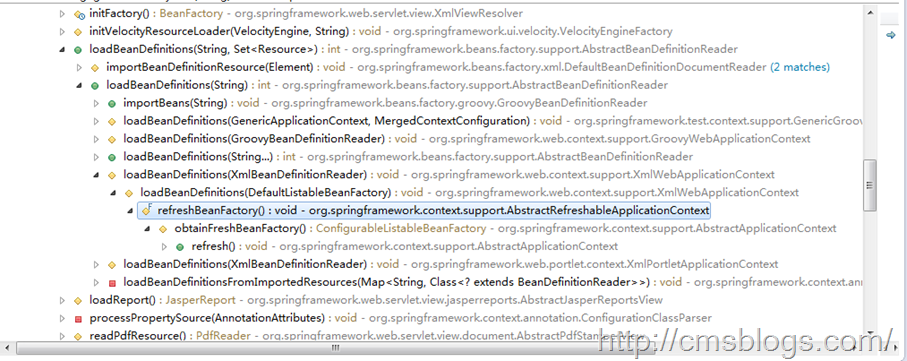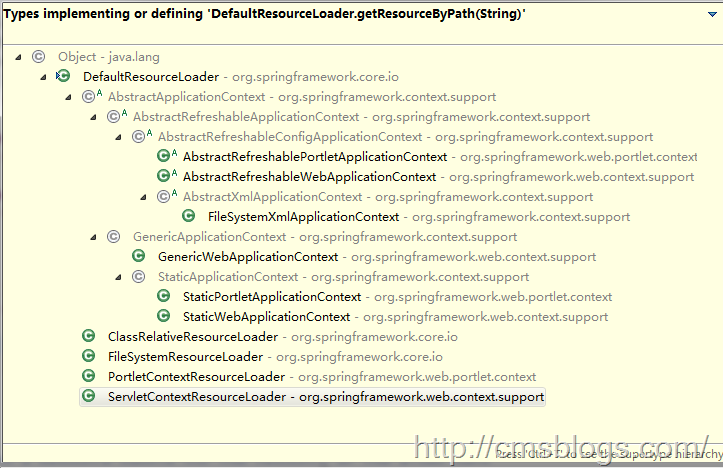【初探Spring】------Spring IOC(三):初始化过程---Resource定位
我们知道Spring的IoC起到了一个容器的作用,其中装得都是各种各样的Bean。同时在我们刚刚开始学习Spring的时候都是通过xml文件来定义Bean,Spring会某种方式加载这些xml文件,然后根据这些信息绑定整个系统的对象,最终组装成一个可用的基于轻量级容器的应用系统。
Spring IoC容器整体可以划分为两个阶段,容器启动阶段,Bean实例化阶段。其中容器启动阶段主要包括加载配置信息、解析配置信息,装备到BeanDefinition中以及其他后置处理,而Bean实例化阶段主要包括实例化对象,装配依赖,生命周期管理已经注册回调。下面LZ先介绍容器的启动阶段的第一步,即定位配置文件。
我们使用编程方式使用DefaultListableBeanFactory时,首先是需要定义一个Resource来定位容器使用的BeanDefinition。
ClassPathResource resource = new ClassPathResource("bean.xml");
通过这个代码,就意味着Spring会在类路径中去寻找bean.xml并解析为BeanDefinition信息。当然这个Resource并不能直接被使用,他需要被BeanDefinitionReader进行解析处理(这是后面的内容了)。
对于各种applicationContext,如FileSystemXmlApplicationContext、ClassPathXmlApplicationContext等等,我们从这些类名就可以看到他们提供了那些Resource的读入功能。下面我们以FileSystemXmlApplicationContext为例来阐述Spring IoC容器的Resource定位。
先看FileSystemXmlApplicationContext继承体系结构:

从图中可以看出FileSystemXMLApplicationContext继承了DefaultResourceLoader,具备了Resource定义的BeanDefinition的能力,其源代码如下:
public class FileSystemXmlApplicationContext extends AbstractXmlApplicationContext {
/**
* 默认构造函数
*/
public FileSystemXmlApplicationContext() {
}
public FileSystemXmlApplicationContext(ApplicationContext parent) {
super(parent);
}
public FileSystemXmlApplicationContext(String configLocation) throws BeansException {
this(new String[] {configLocation}, true, null);
}
public FileSystemXmlApplicationContext(String... configLocations) throws BeansException {
this(configLocations, true, null);
}
public FileSystemXmlApplicationContext(String[] configLocations, ApplicationContext parent) throws BeansException {
this(configLocations, true, parent);
}
public FileSystemXmlApplicationContext(String[] configLocations, boolean refresh) throws BeansException {
this(configLocations, refresh, null);
}
//核心构造器
public FileSystemXmlApplicationContext(String[] configLocations, boolean refresh, ApplicationContext parent)
throws BeansException {
super(parent);
setConfigLocations(configLocations);
if (refresh) {
refresh();
}
}
//通过构造一个FileSystemResource对象来得到一个在文件系统中定位的BeanDefinition
//采用模板方法设计模式,具体的实现用子类来完成
protected Resource getResourceByPath(String path) {
if (path != null && path.startsWith("/")) {
path = path.substring(1);
}
return new FileSystemResource(path);
}
}
AbstractApplicationContext中的refresh()方法是IoC容器初始化的入口,也就是说IoC容器的初始化是通过refresh()方法来完成整个调用过程的。在核心构造器中就对refresh进行调用,通过它来启动IoC容器的初始化工作。getResourceByPath为一个模板方法,通过构造一个FileSystemResource对象来得到一个在文件系统中定位的BeanDEfinition。getResourceByPath的调用关系如下(部分):

refresh为初始化IoC容器的入口,但是具体的资源定位还是在XmlBeanDefinitionReader读入BeanDefinition时完成,loadBeanDefinitions() 加载BeanDefinition的载入。
protected final void refreshBeanFactory() throws BeansException {
//判断是否已经创建了BeanFactory,如果创建了则销毁关闭该BeanFactory
if (hasBeanFactory()) {
destroyBeans();
closeBeanFactory();
}
try {
//创建DefaultListableBeanFactory实例对象
DefaultListableBeanFactory beanFactory = createBeanFactory();
beanFactory.setSerializationId(getId());
customizeBeanFactory(beanFactory);
//加载BeanDefinition信息
loadBeanDefinitions(beanFactory);
synchronized (this.beanFactoryMonitor) {
this.beanFactory = beanFactory;
}
}
catch (IOException ex) {
throw new ApplicationContextException("I/O error parsing bean definition source for " + getDisplayName(), ex);
}
}
DefaultListableBeanFactory作为BeanFactory默认实现类,其重要性不言而喻,而createBeanFactory()则返回该实例对象。
protected DefaultListableBeanFactory createBeanFactory() {
return new DefaultListableBeanFactory(getInternalParentBeanFactory());
}
loadBeanDefinition方法加载BeanDefinition信息,BeanDefinition就是在这里定义的。AbstractRefreshableApplicationContext对loadBeanDefinitions仅仅只是定义了一个抽象的方法,真正的实现类为其子类AbstractXmlApplicationContext来实现:
AbstractRefreshableApplicationContext:
protected abstract void loadBeanDefinitions(DefaultListableBeanFactory beanFactory)
throws BeansException, IOException;
AbstractXmlApplicationContext:
protected void loadBeanDefinitions(DefaultListableBeanFactory beanFactory) throws BeansException, IOException {
//创建bean的读取器(Reader),即XmlBeanDefinitionReader,并通过回调设置到容器中
XmlBeanDefinitionReader beanDefinitionReader = new XmlBeanDefinitionReader(beanFactory);
//
beanDefinitionReader.setEnvironment(getEnvironment());
//为Bean读取器设置Spring资源加载器
beanDefinitionReader.setResourceLoader(this);
//为Bean读取器设置SAX xml解析器
beanDefinitionReader.setEntityResolver(new ResourceEntityResolver(this));
//
initBeanDefinitionReader(beanDefinitionReader);
//Bean读取器真正实现的地方
loadBeanDefinitions(beanDefinitionReader);
}
程序首先首先创建一个Reader,在前面就提到过,每一类资源都对应着一个BeanDefinitionReader,BeanDefinitionReader提供统一的转换规则;然后设置Reader,最后调用loadBeanDefinition,该loadBeanDefinition才是读取器真正实现的地方:
protected void loadBeanDefinitions(XmlBeanDefinitionReader reader) throws BeansException, IOException {
//获取Bean定义资源的定位
Resource[] configResources = getConfigResources();
if (configResources != null) {
reader.loadBeanDefinitions(configResources);
}
//获取Bean定义资源的路径。在FileSystemXMLApplicationContext中通过setConfigLocations可以配置Bean资源定位的路径
String[] configLocations = getConfigLocations();
if (configLocations != null) {
reader.loadBeanDefinitions(configLocations);
}
}
首先通过getConfigResources()获取Bean定义的资源定位,如果不为null则调用loadBeanDefinitions方法来读取Bean定义资源的定位。
loadBeanDefinitions是中的方法:
public int loadBeanDefinitions(String... locations) throws BeanDefinitionStoreException {
Assert.notNull(locations, "Location array must not be null");
int counter = 0;
for (String location : locations) {
counter += loadBeanDefinitions(location);
}
return counter;
}
继续:
public int loadBeanDefinitions(String location) throws BeanDefinitionStoreException {
return loadBeanDefinitions(location, null);
}
再继续:
public int loadBeanDefinitions(String location, Set<Resource> actualResources) throws BeanDefinitionStoreException {
//获取ResourceLoader资源加载器
ResourceLoader resourceLoader = getResourceLoader();
if (resourceLoader == null) {
throw new BeanDefinitionStoreException(
"Cannot import bean definitions from location [" + location + "]: no ResourceLoader available");
}
//
if (resourceLoader instanceof ResourcePatternResolver) {
try {
//调用DefaultResourceLoader的getResourceByPath完成具体的Resource定位
Resource[] resources = ((ResourcePatternResolver) resourceLoader).getResources(location);
int loadCount = loadBeanDefinitions(resources);
if (actualResources != null) {
for (Resource resource : resources) {
actualResources.add(resource);
}
}
if (logger.isDebugEnabled()) {
logger.debug("Loaded " + loadCount + " bean definitions from location pattern [" + location + "]");
}
return loadCount;
}
catch (IOException ex) {
throw new BeanDefinitionStoreException(
"Could not resolve bean definition resource pattern [" + location + "]", ex);
}
}
else {
//调用DefaultResourceLoader的getResourceByPath完成具体的Resource定位
Resource resource = resourceLoader.getResource(location);
int loadCount = loadBeanDefinitions(resource);
if (actualResources != null) {
actualResources.add(resource);
}
if (logger.isDebugEnabled()) {
logger.debug("Loaded " + loadCount + " bean definitions from location [" + location + "]");
}
return loadCount;
}
}
在这段源代码中通过调用DefaultResourceLoader的getResource方法:
public Resource getResource(String location) {
Assert.notNull(location, "Location must not be null");
if (location.startsWith("/")) {
return getResourceByPath(location);
}
//处理带有classPath标识的Resource
else if (location.startsWith(CLASSPATH_URL_PREFIX)) {
return new ClassPathResource(location.substring(CLASSPATH_URL_PREFIX.length()), getClassLoader());
}
else {
try {
//处理URL资源
URL url = new URL(location);
return new UrlResource(url);
}
catch (MalformedURLException ex) {
return getResourceByPath(location);
}
}
}
在getResource方法中我们可以清晰地看到Resource资源的定位。这里可以清晰地看到getResourceByPath方法的调用,getResourceByPath方法的具体实现有子类来完成,在FileSystemXmlApplicationContext实现如下:
protected Resource getResourceByPath(String path) {
if (path != null && path.startsWith("/")) {
path = path.substring(1);
}
return new FileSystemResource(path);
}
这样代码就回到了博客开初的FileSystemXmlApplicationContext 中来了,它提供了FileSystemResource 来完成从文件系统得到配置文件的资源定义。当然这仅仅只是Spring IoC容器定位资源的一种逻辑,我们可以根据这个步骤来查看Spring提供的各种资源的定位,如ClassPathResource、URLResource等等。下图是ResourceLoader的继承关系:

这里就差不多分析了Spring IoC容器初始化过程资源的定位,在BeanDefinition定位完成的基础上,就可以通过返回的Resource对象来进行BeanDefinition的载入、解析了。
下篇博客将探索Spring IoC容器初始化过程的解析,Spring Resource体系结构会在后面详细讲解。
参考文献
1、《Spring技术内幕 深入解析Spring架构与设计原理》--第二版
3、【Spring】IOC核心源码学习(二):容器初始化过程
【初探Spring】------Spring IOC(三):初始化过程---Resource定位的更多相关文章
- Spring之IOC容器初始化过程
Ioc容器的初始化是由refresh()方法来启动的,这个方法标志着Ioc容器的正式启动. 具体来说这个启动过程包括三个基本过程: 1.BeanDifinition的Resource定位 2.Bean ...
- Spring Boot IoC 容器初始化过程
1. 加载 ApplicationContextInializer & ApplicationListener 2. 初始化环境 ConfigurableEnvironment & 加 ...
- Spring IoC容器初始化过程学习
IoC容器是什么?IoC文英全称Inversion of Control,即控制反转,我么可以这么理解IoC容器: 把某些业务对象的的控制权交给一个平台或者框架来同一管理,这个同一管理的平台可以称为I ...
- 十二、Spring之IOC容器初始化
Spring之IOC容器初始化 前言 在前面我们分析了最底层的IOC容器BeanFactory,接着简单分析了高级形态的容器ApplicationContext,在ApplicationContext ...
- spring internalTransactionAdvisor 事务 advisor 初始化过程
spring internalTransactionAdvisor 事务 advisor 初始化过程:
- Spring源码解析二:IOC容器初始化过程详解
IOC容器初始化分为三个步骤,分别是: 1.Resource定位,即BeanDefinition的资源定位. 2.BeanDefinition的载入 3.向IOC容器注册BeanDefinition ...
- spring源码学习之路---深度分析IOC容器初始化过程(四)
作者:zuoxiaolong8810(左潇龙),转载请注明出处,特别说明:本博文来自博主原博客,为保证新博客中博文的完整性,特复制到此留存,如需转载请注明新博客地址即可. 最近由于工作和生活,学习耽搁 ...
- Spring Ioc 容器初始化过程
IOC 是如何工作的? 通过 ApplicationContext 创建 Spring 容器,容器读取配置文件 "/beans.xml" 并管理定义的 Bean 实例对象. 通 ...
- 挖坟之Spring.NET IOC容器初始化
因查找ht项目中一个久未解决spring内部异常,翻了一段时间源码.以此文总结springIOC,容器初始化过程. 语言背景是C#.网上有一些基于java的spring源码分析文档,大而乱,乱而不全, ...
随机推荐
- JavaScript之父Brendan Eich,Clojure 创建者Rich Hickey,Python创建者Van Rossum等编程大牛对程序员的职业建议
软件开发是现时很火的职业.据美国劳动局发布的一项统计数据显示,从2014年至2024年,美国就业市场对开发人员的需求量将增长17%,而这个增长率比起所有职业的平均需求量高出了7%.很多人年轻人会选择编 ...
- Jenkins 安装的HTML Publisher Plugin 插件无法展示ant生成的JunitReport报告
最近在做基于jenkins ant junit 的测试持续集成,单独ant junit生成的junitreport报告打开正常,使用Jenkins的HTML Publisher Plugin 插件无 ...
- less学习
// 1.变量:颜色可做+- // from @nice-blue: #5B83AD; @light-blue: @nice-blue + #111; #header { color: @light- ...
- Visaul Studio 常用快捷键的动画演示
从本篇文章开始,我将会陆续介绍提高 VS 开发效率的文章,欢迎大家补充~ 在进行代码开发的时候,我们往往会频繁的使用键盘.鼠标进行协作,但是切换使用两种工具会影响到我们的开发速度,如果所有的操作都可以 ...
- C++中的变长参数
新参与的项目中,为了使用共享内存和自定义内存池,我们自己定义了MemNew函数,且在函数内部对于非pod类型自动执行构造函数.在需要的地方调用自定义的MemNew函数.这样就带来一个问题,使用stl的 ...
- ABP框架 - OData 集成
文档目录 本节内容: 简介 安装 安装Nuget包 设置模块依赖 配置你的实体 创建控制器 示例 获取实体列表 请求 响应 获取单个实体 请求 响应 获取单个实体及导航属性 请求 响应 查询 请求 响 ...
- java EE设计模式简介
1.何为设计模式 设计模式提供了对常见应用设计问题的解决方案.在面向对象的编程中,设计模式通常在解决与对象创建和交互相关的问题,而非整体软件架构所面对的大规模问题,它们以样板代码的形式提供了通用的解决 ...
- Spring框架概述
Spring是最流行的Java企业级应用开发框架,全球数以百万的开发者在使用Spring框架创建高性能.易测试.可重用的代码. Spring框架的核心特性可以应用于任何Java应用,但扩展的JavaE ...
- 消息队列性能对比——ActiveMQ、RabbitMQ与ZeroMQ(译文)
Dissecting Message Queues 概述: 我花了一些时间解剖各种库执行分布式消息.在这个分析中,我看了几个不同的方面,包括API特性,易于部署和维护,以及性能质量..消息队列已经被分 ...
- VB.NET设置控件和窗体的显示级别
前言:在用VB.NET开发射频检测系统ADS时,当激活已存在的目标MDI子窗体时,被其他子窗体遮住了,导致目标MDI子窗体不能显示. 这个问题怎么解决呢?网上看到一篇帖子VB.NET设置控件和窗体的显 ...
